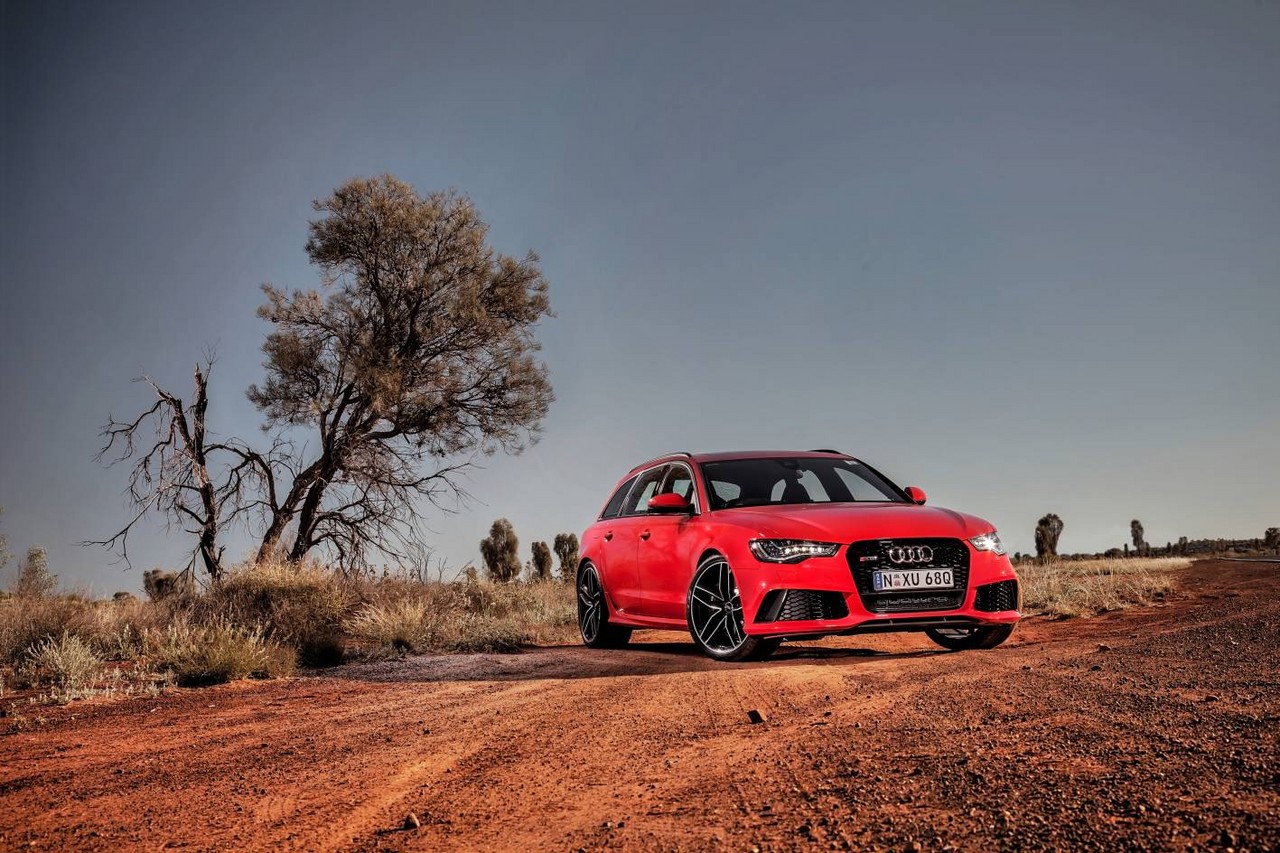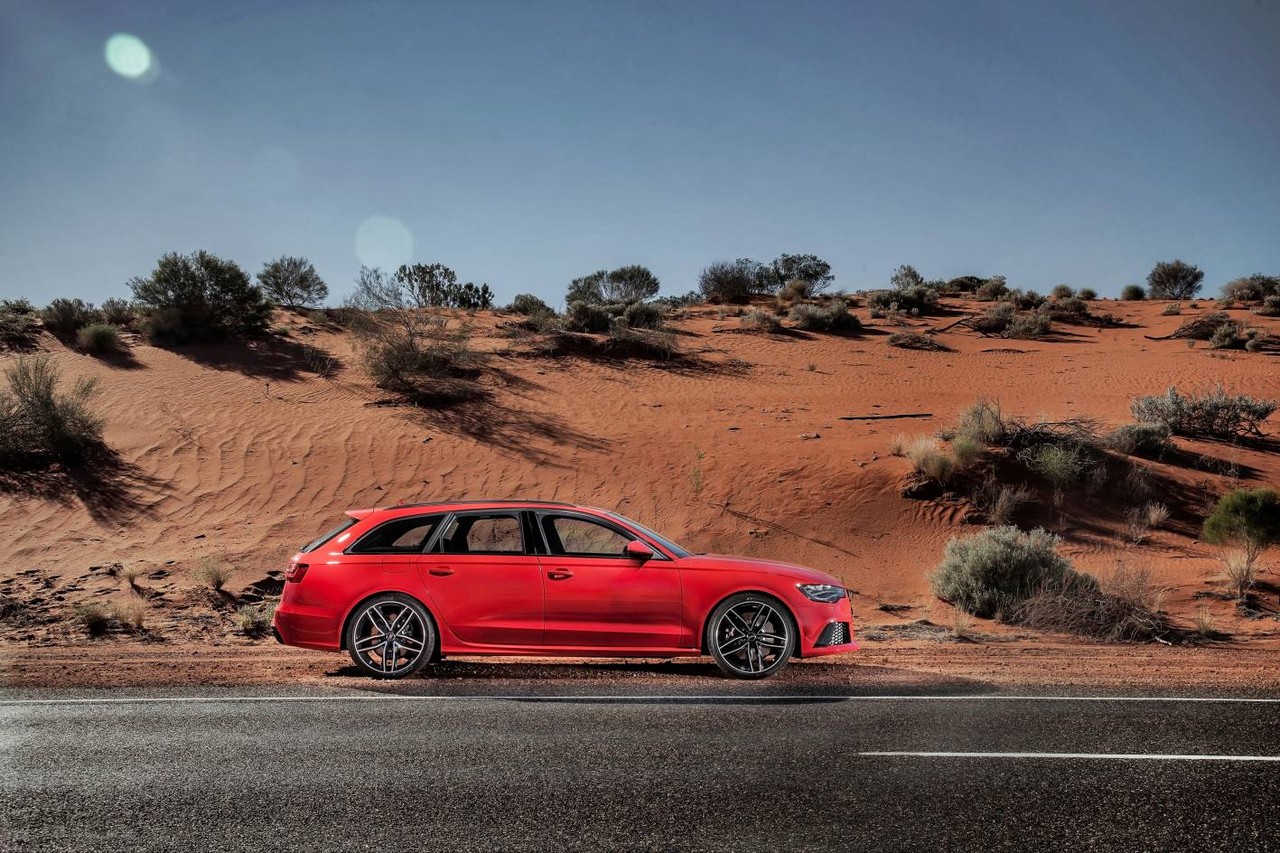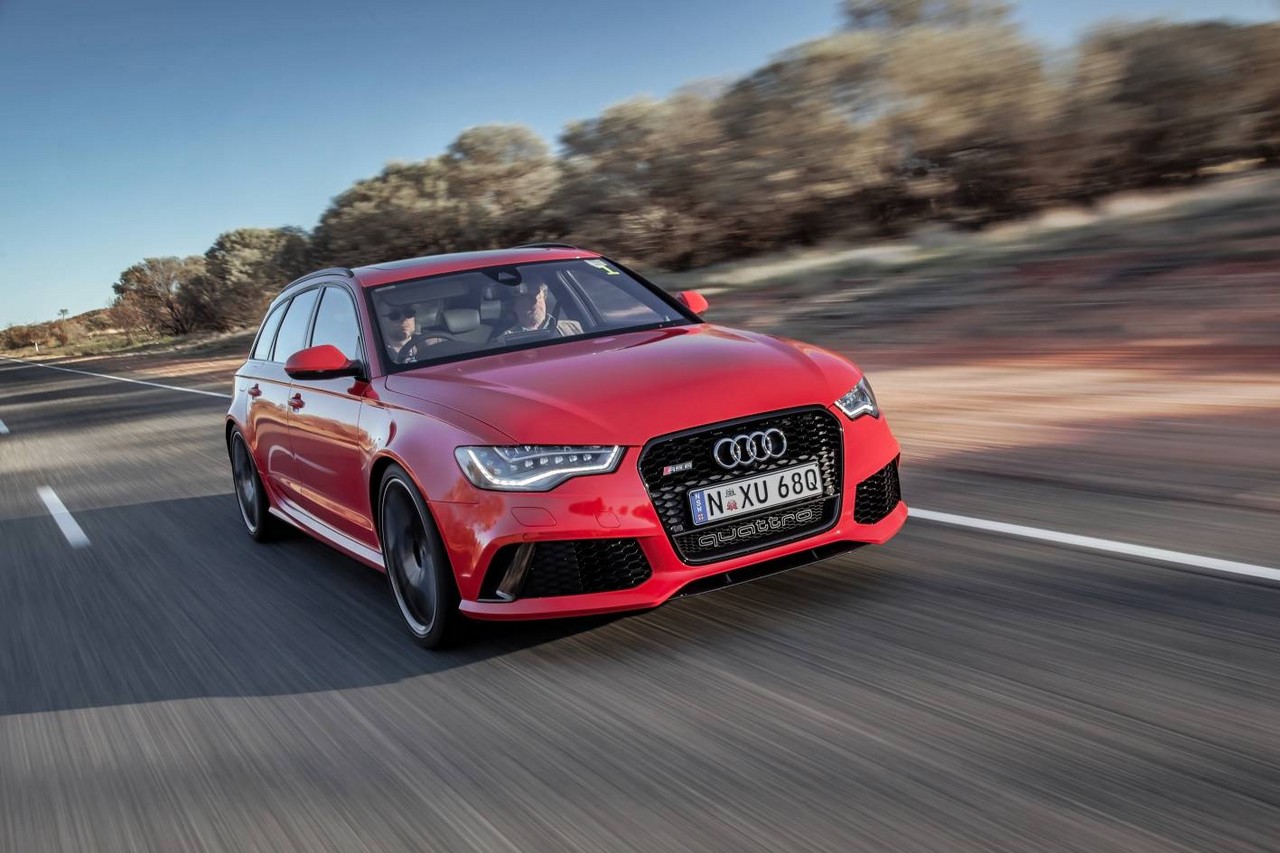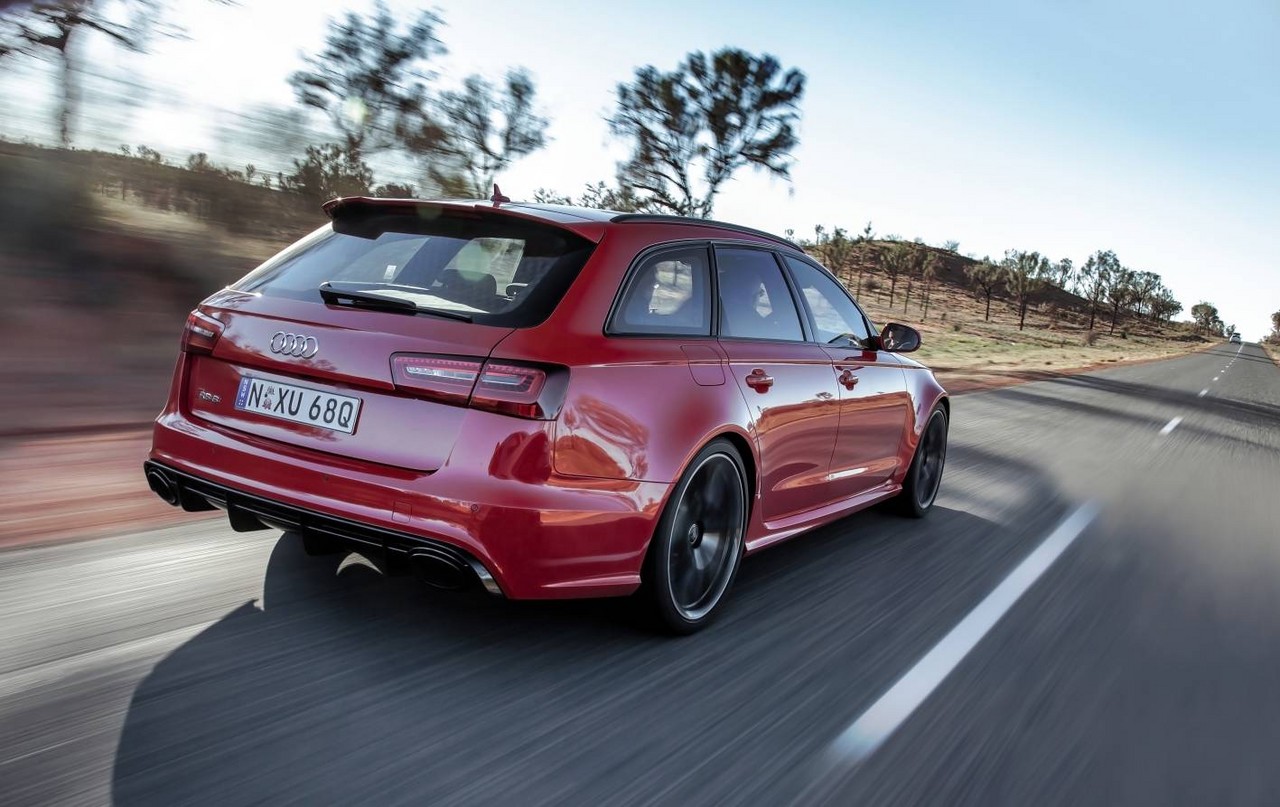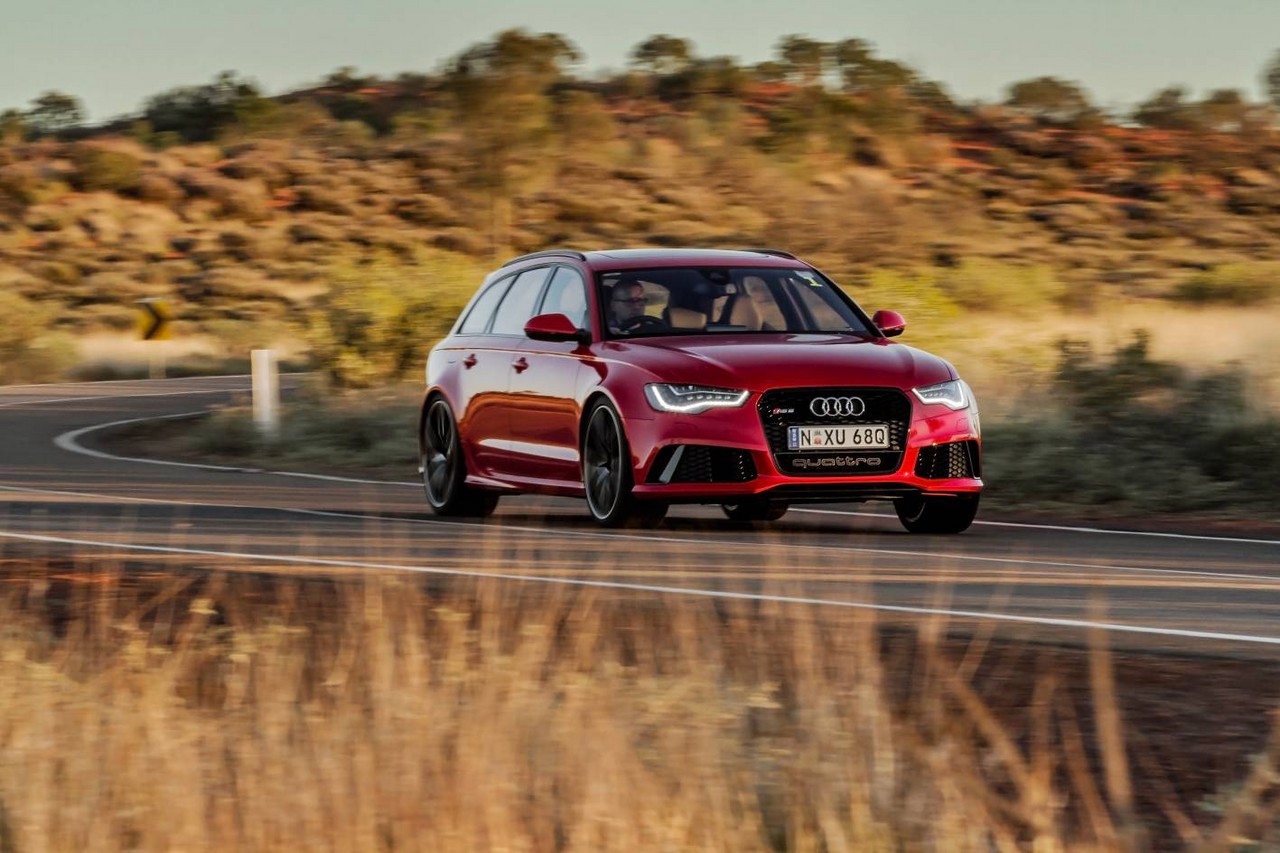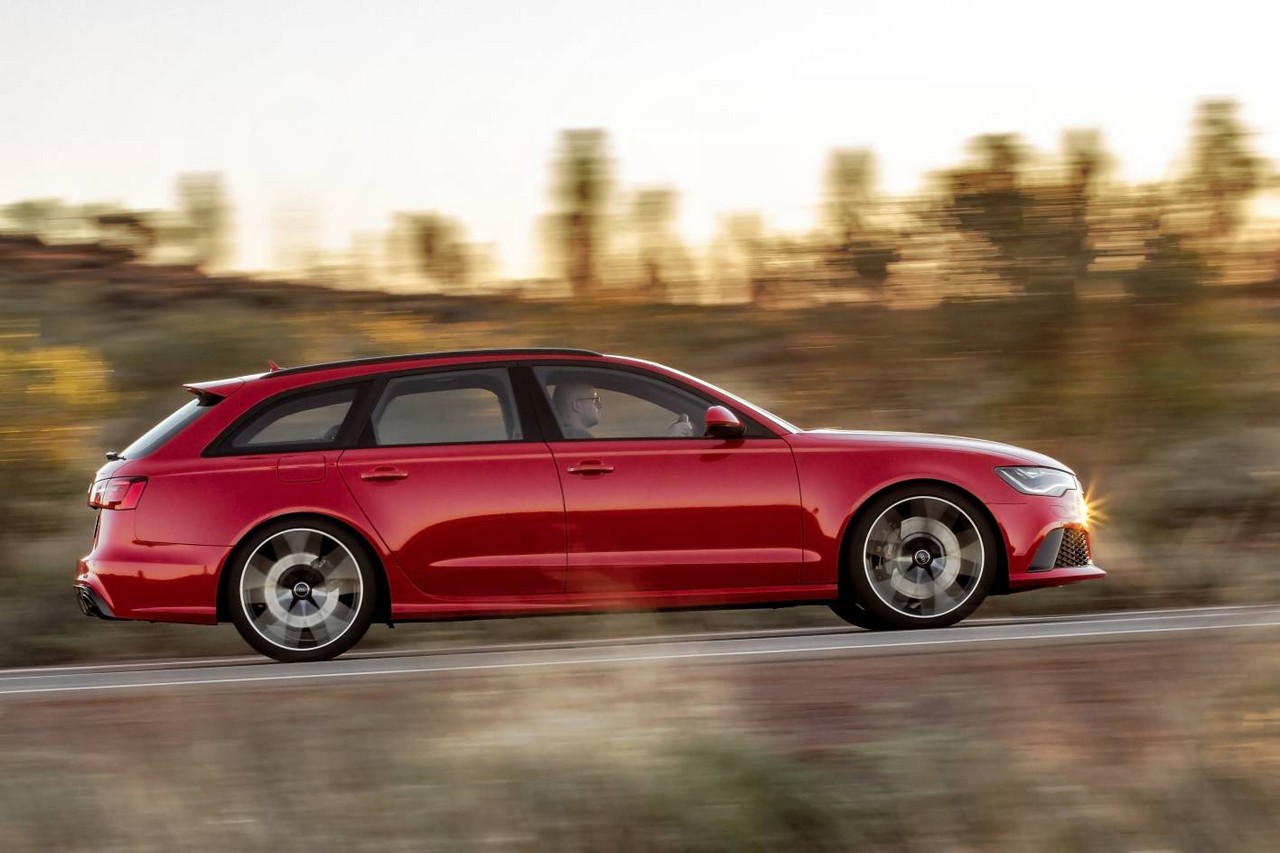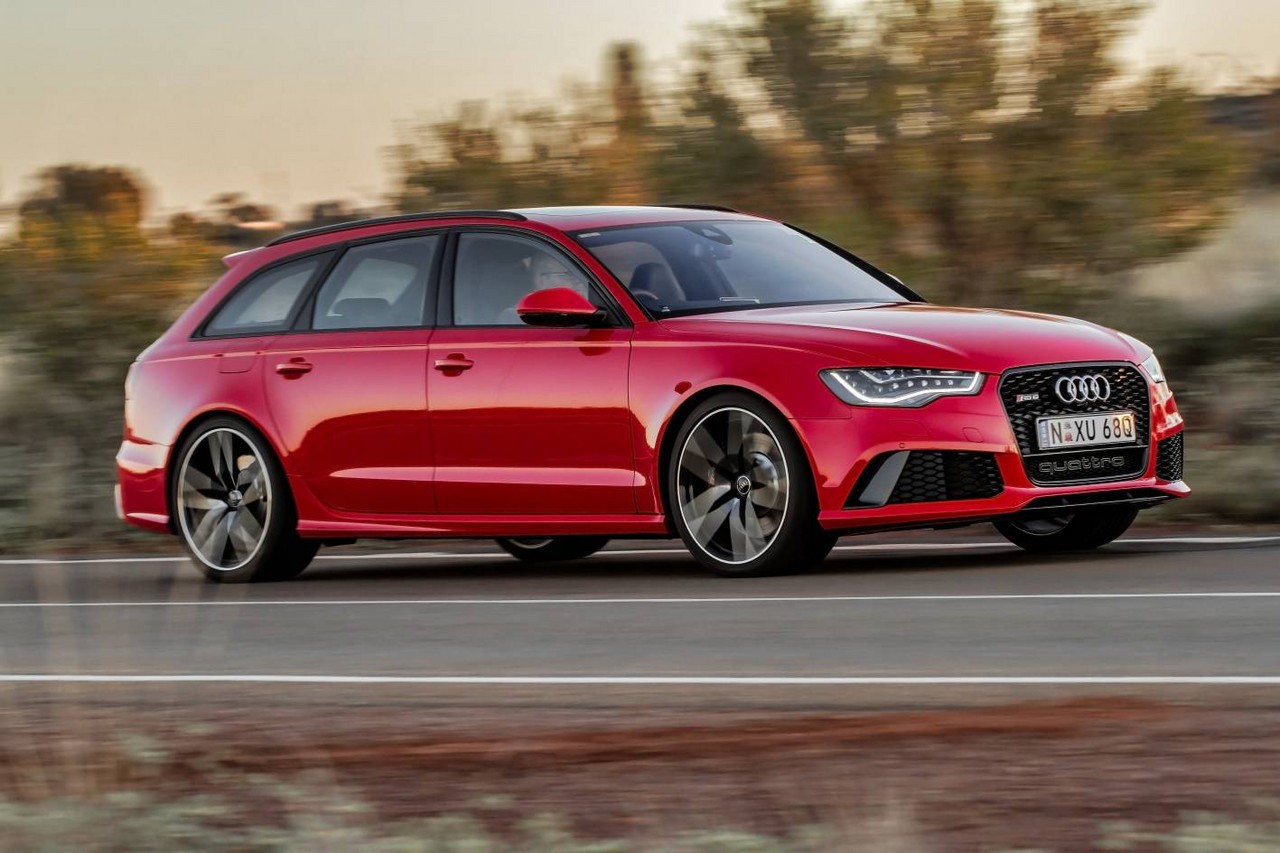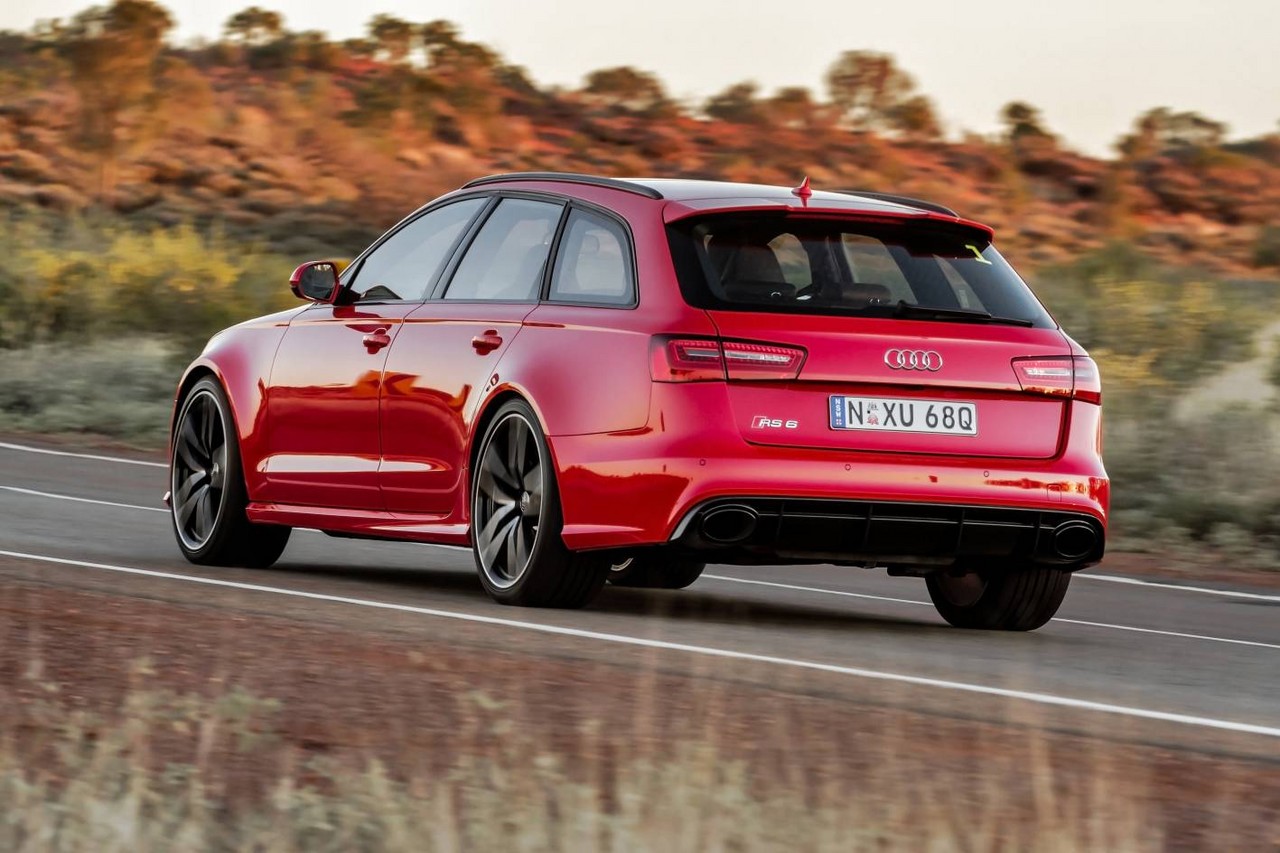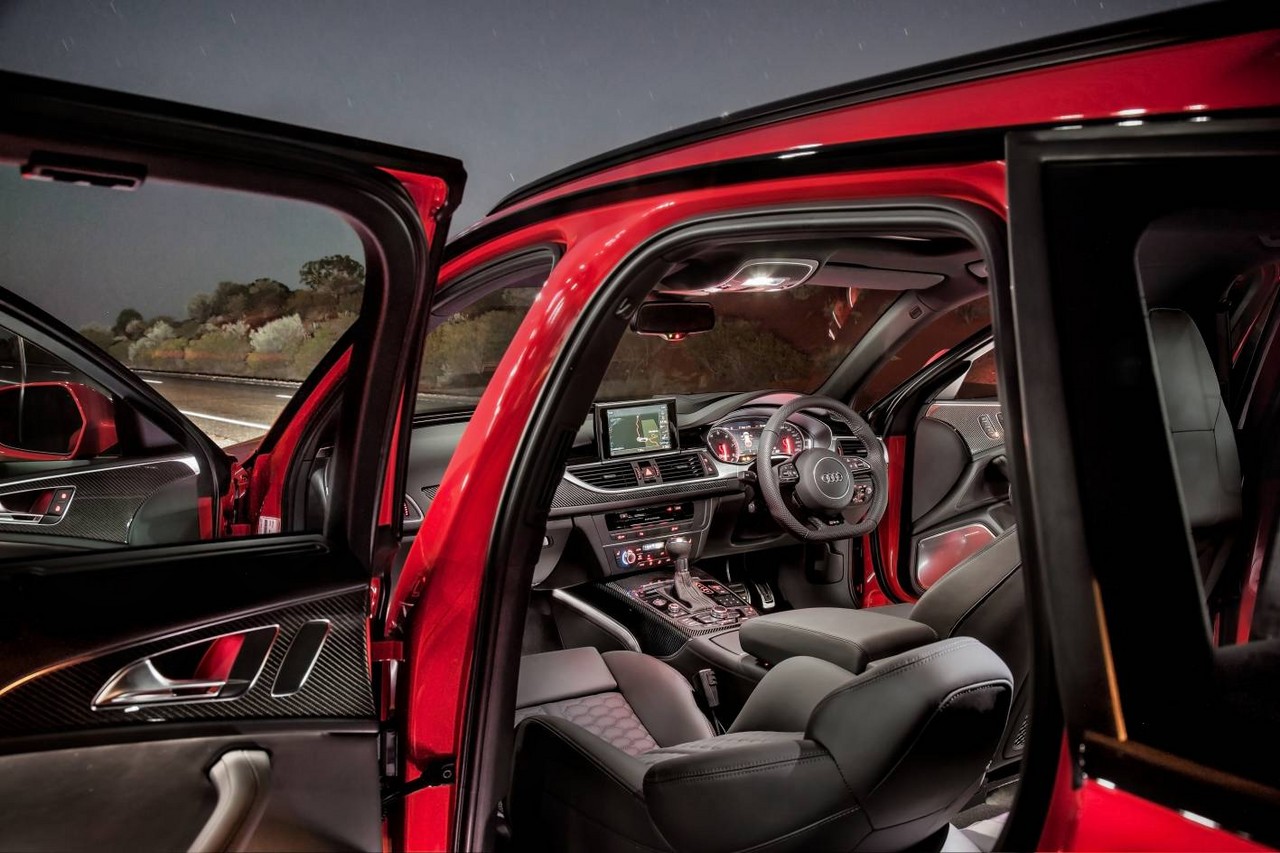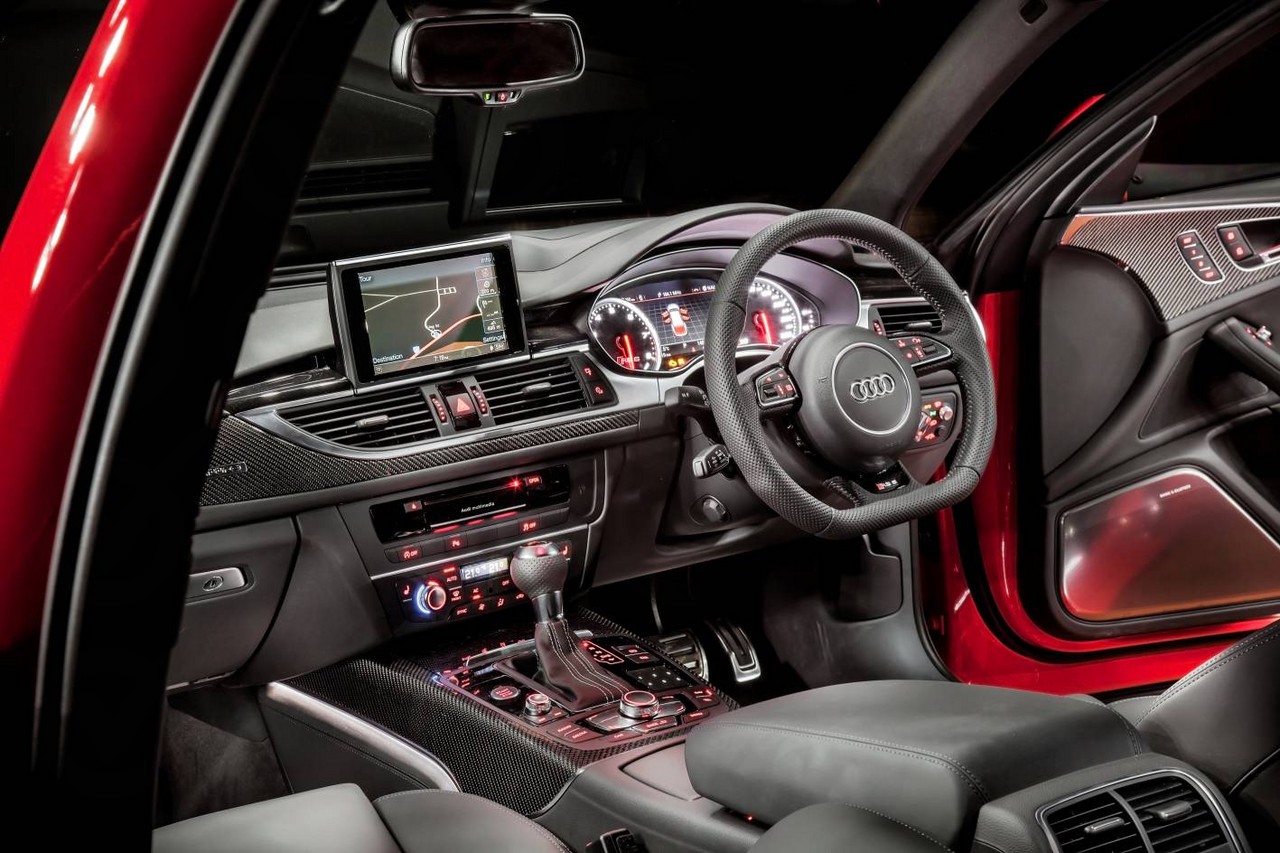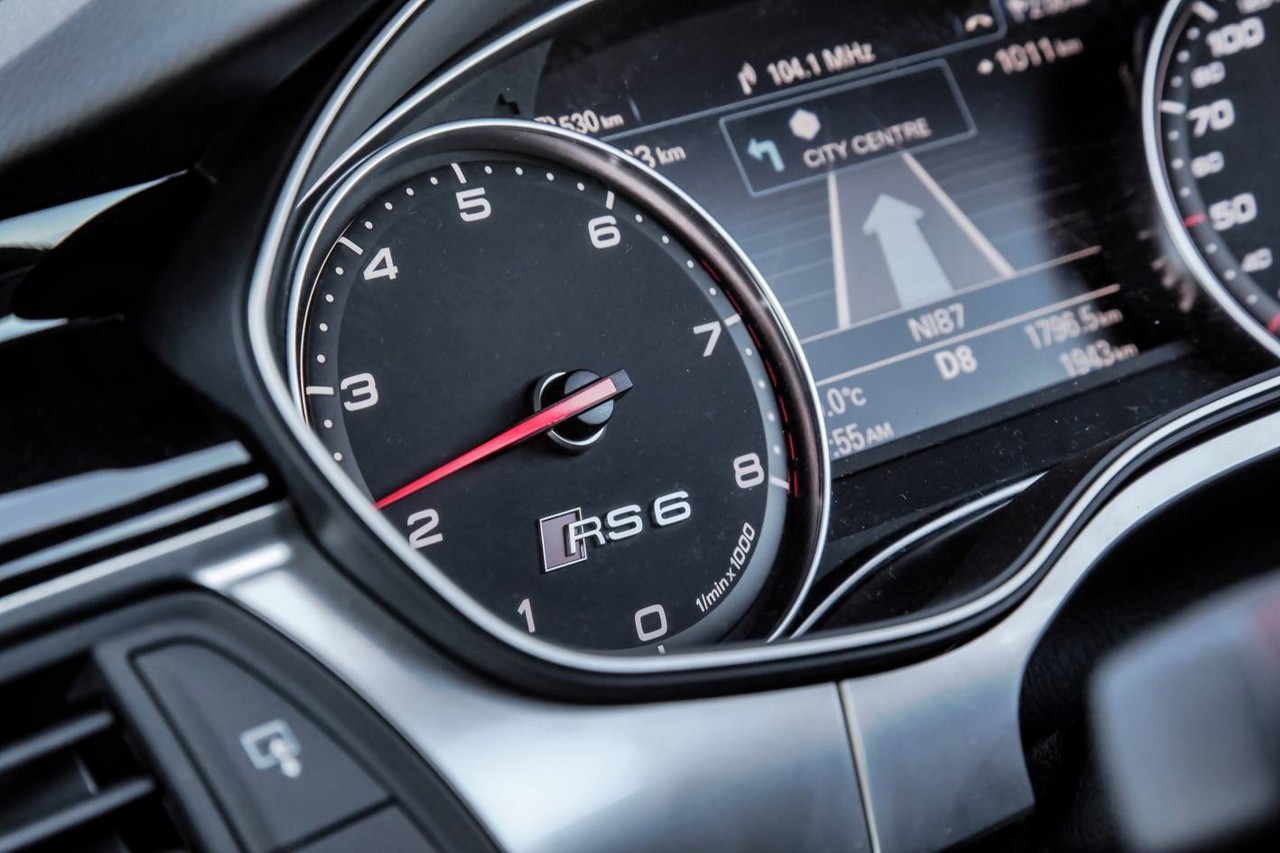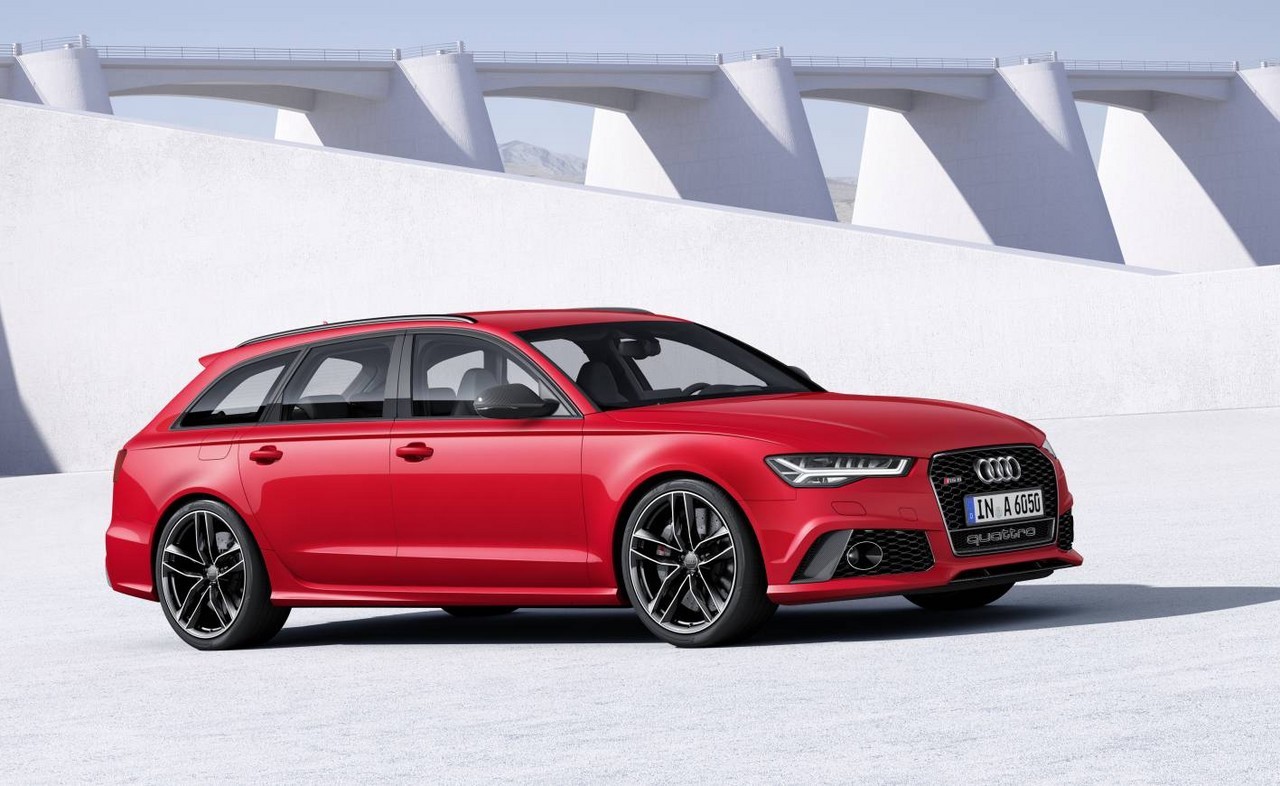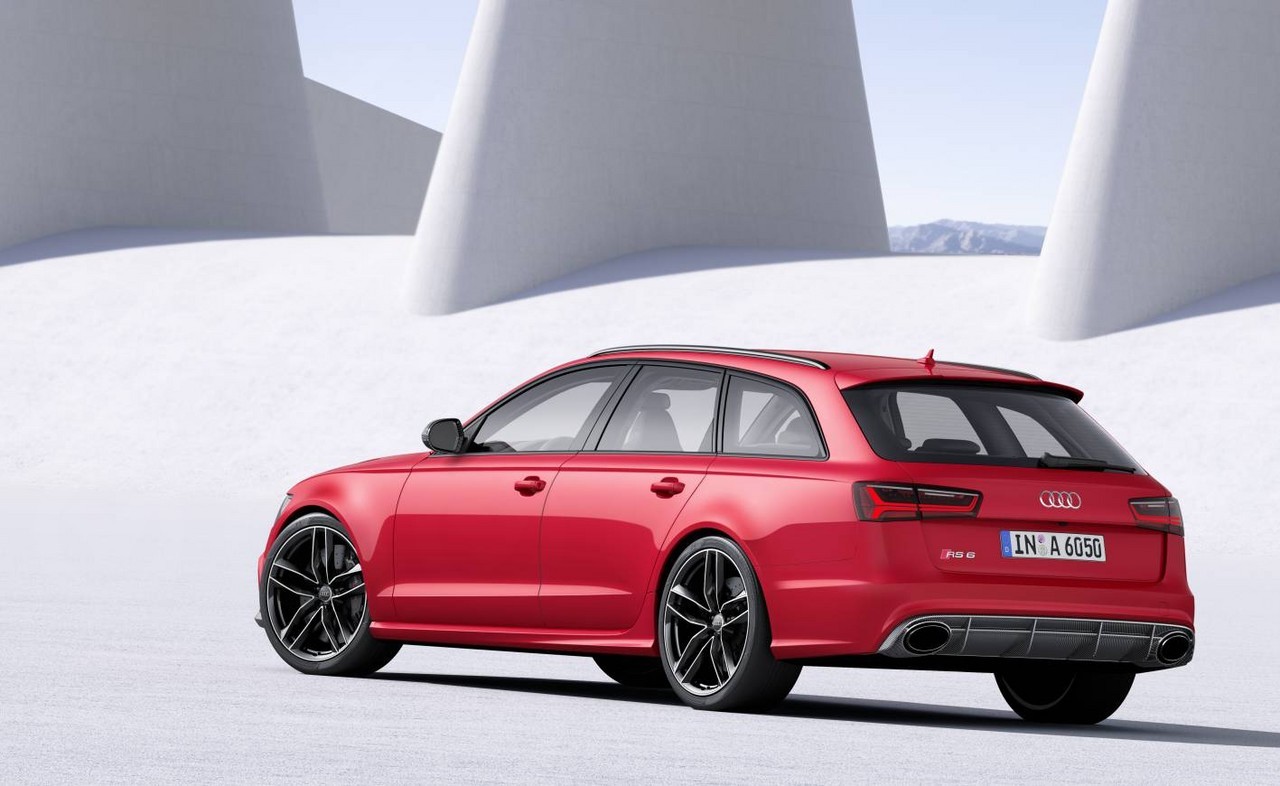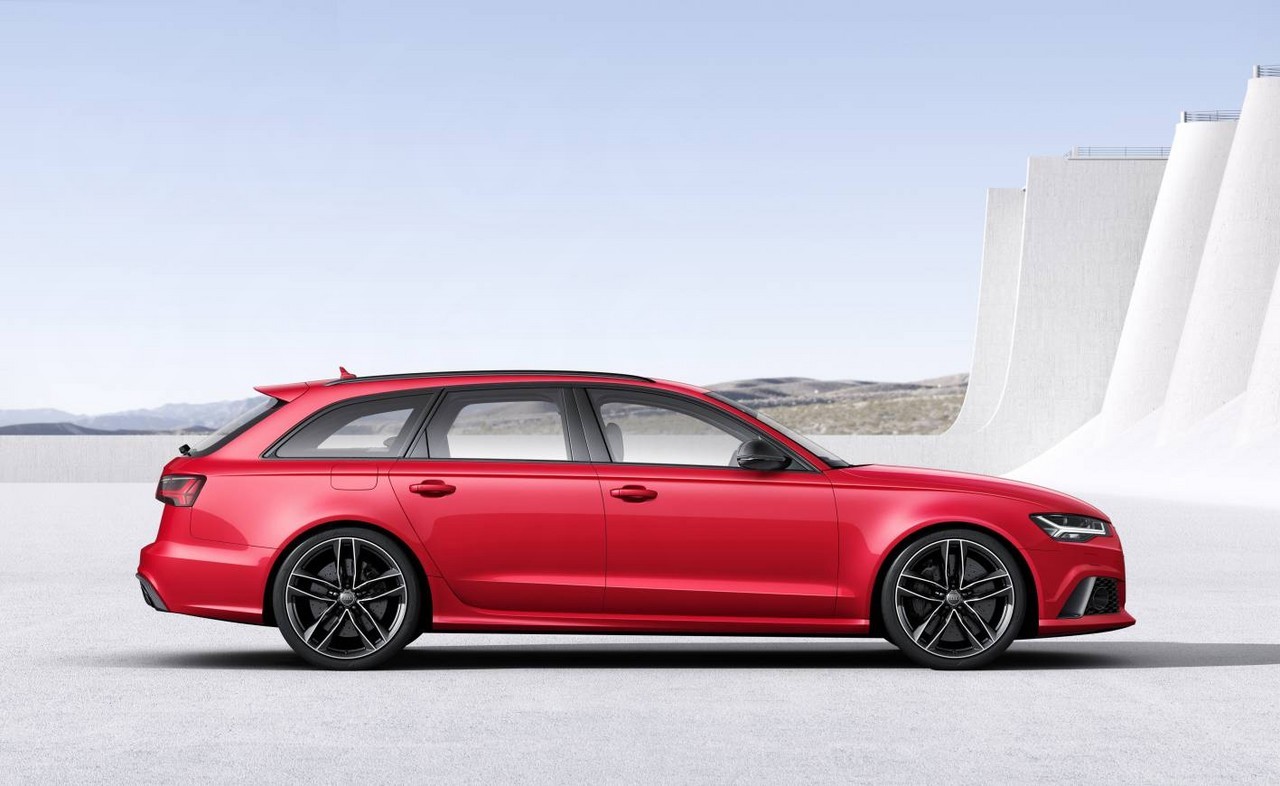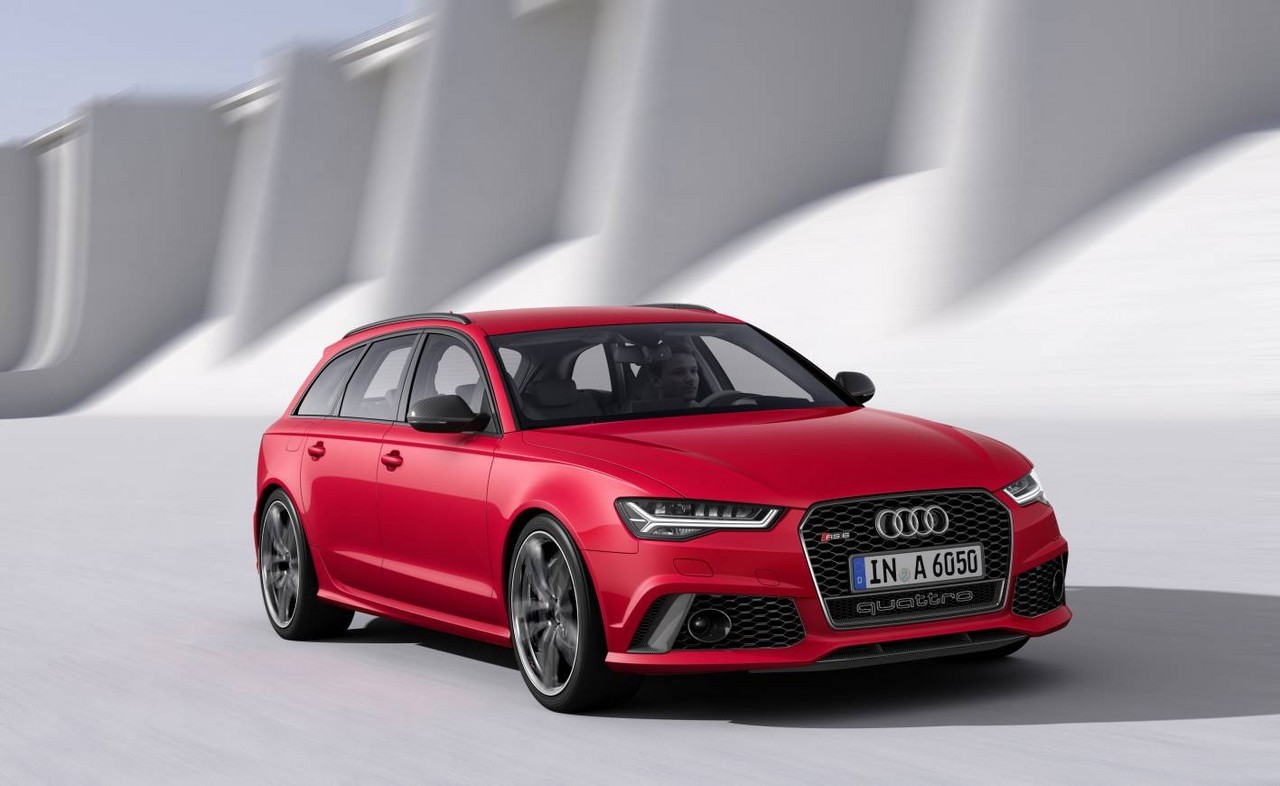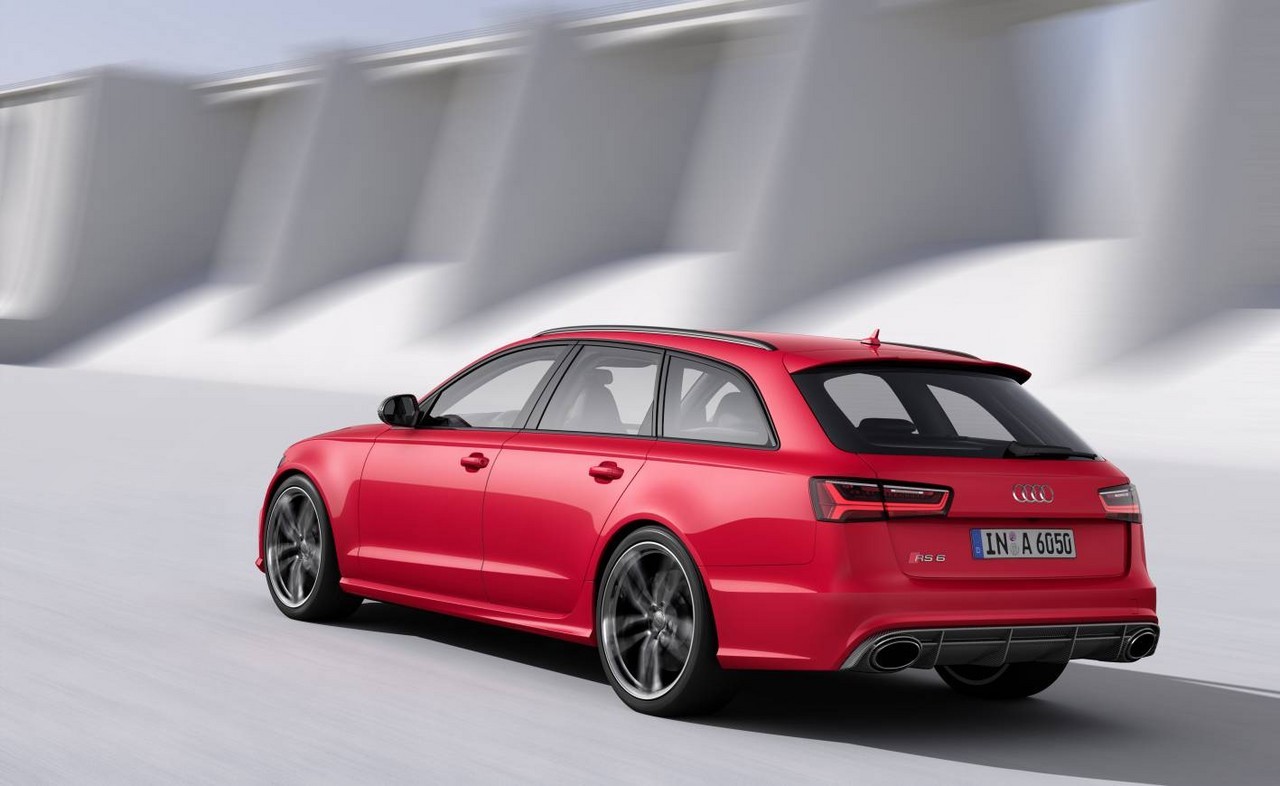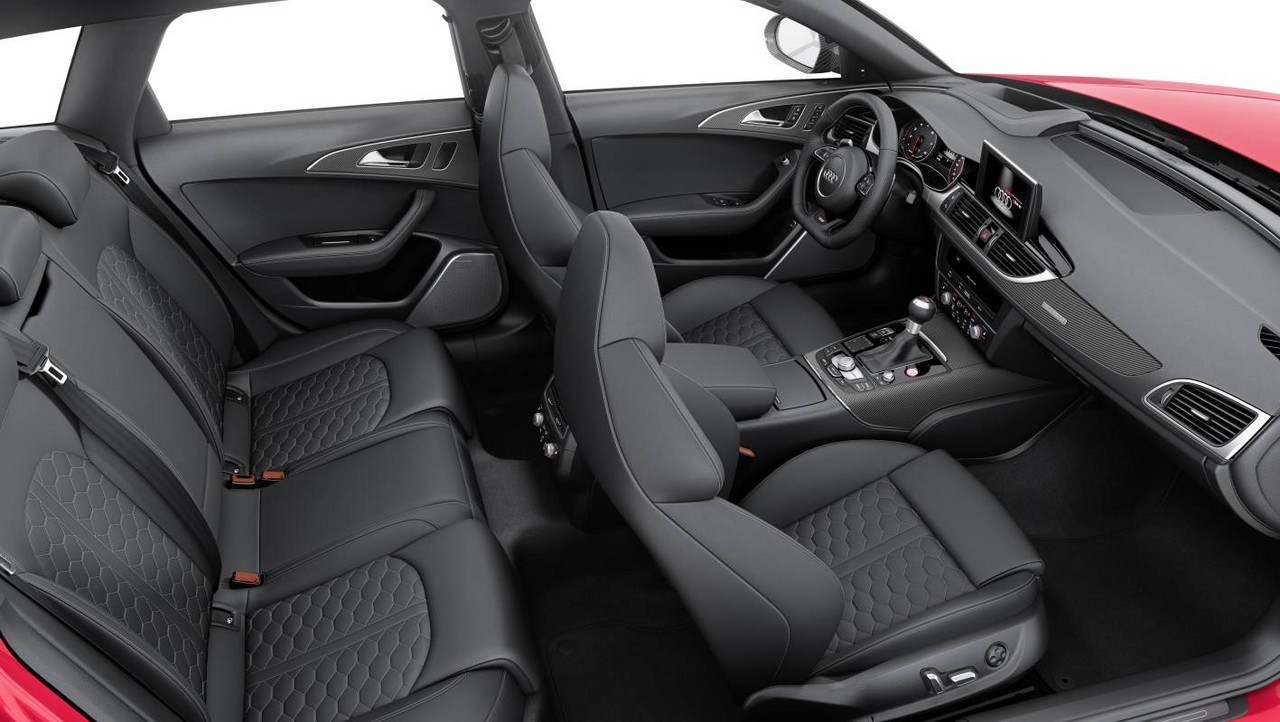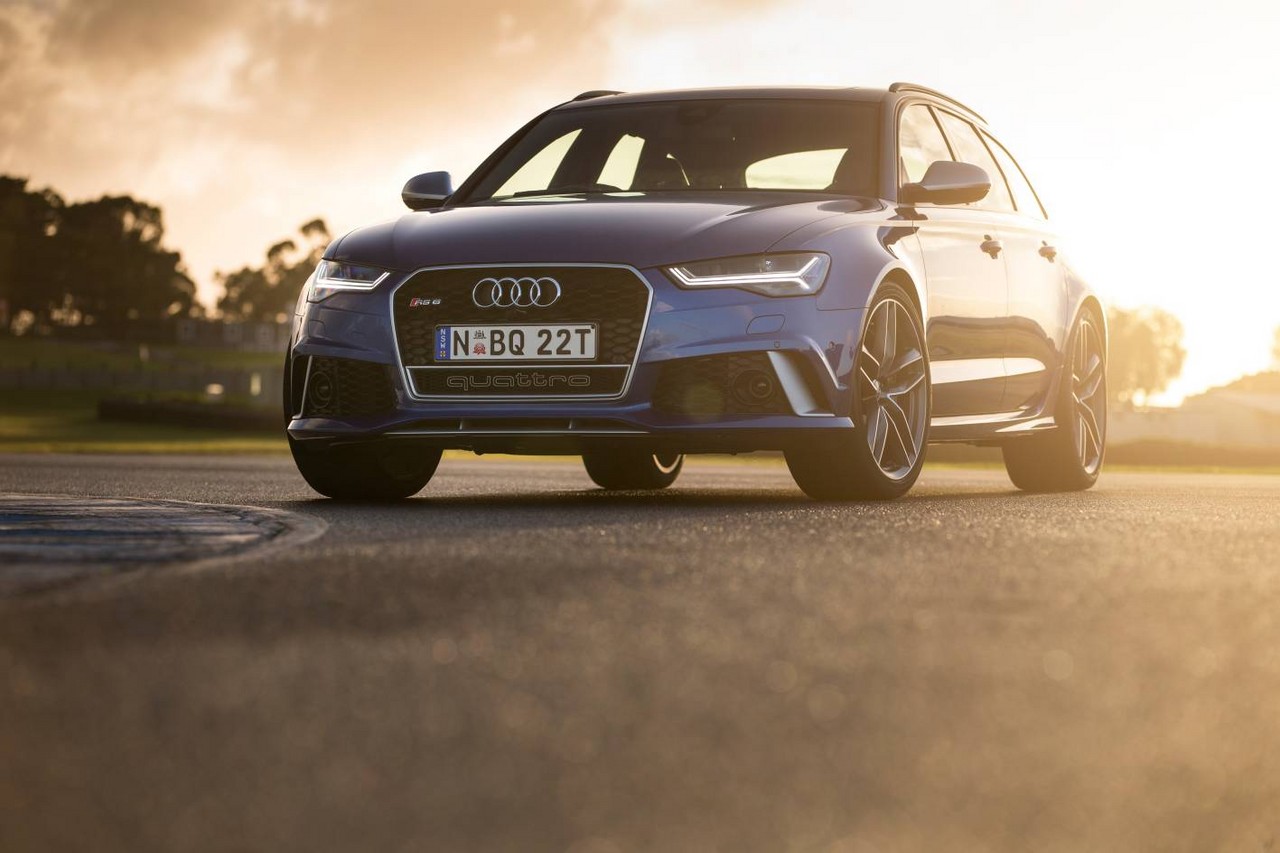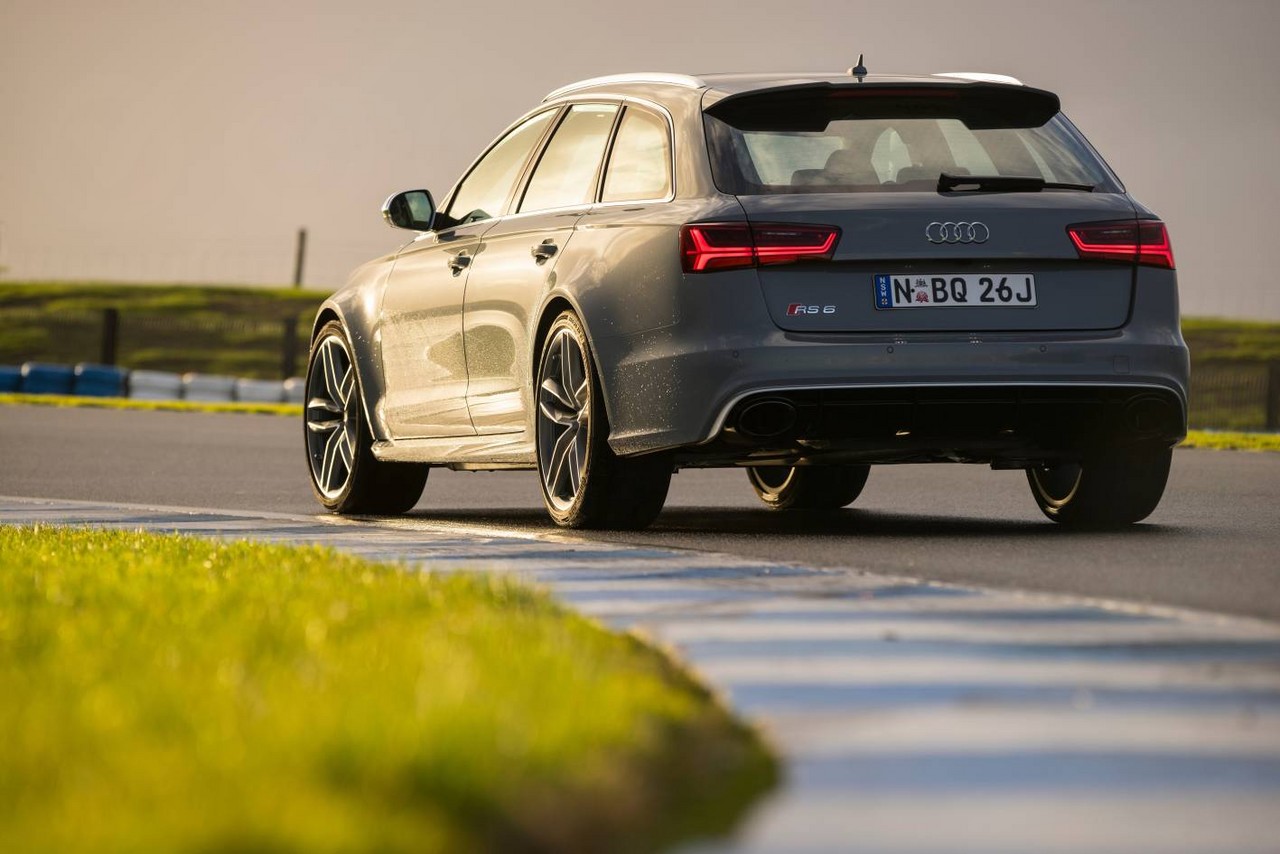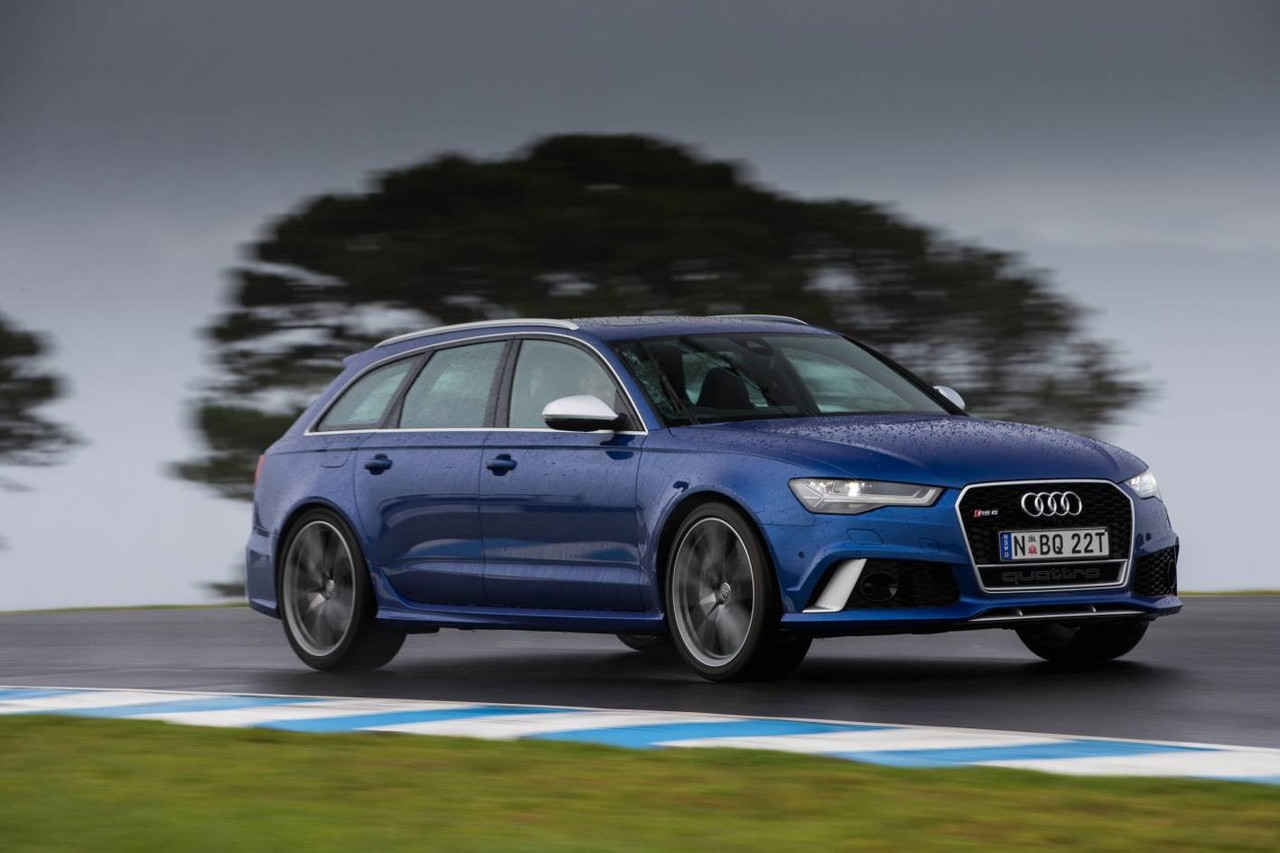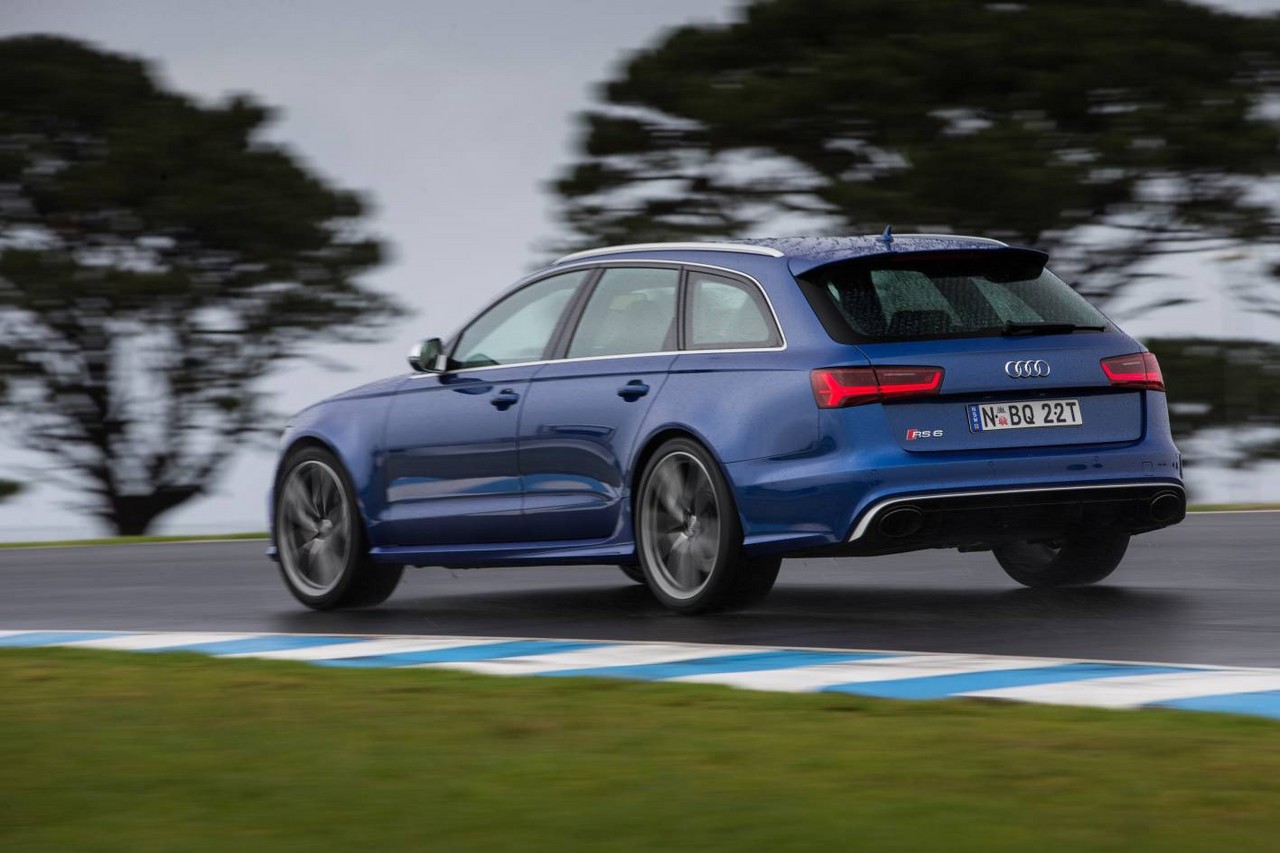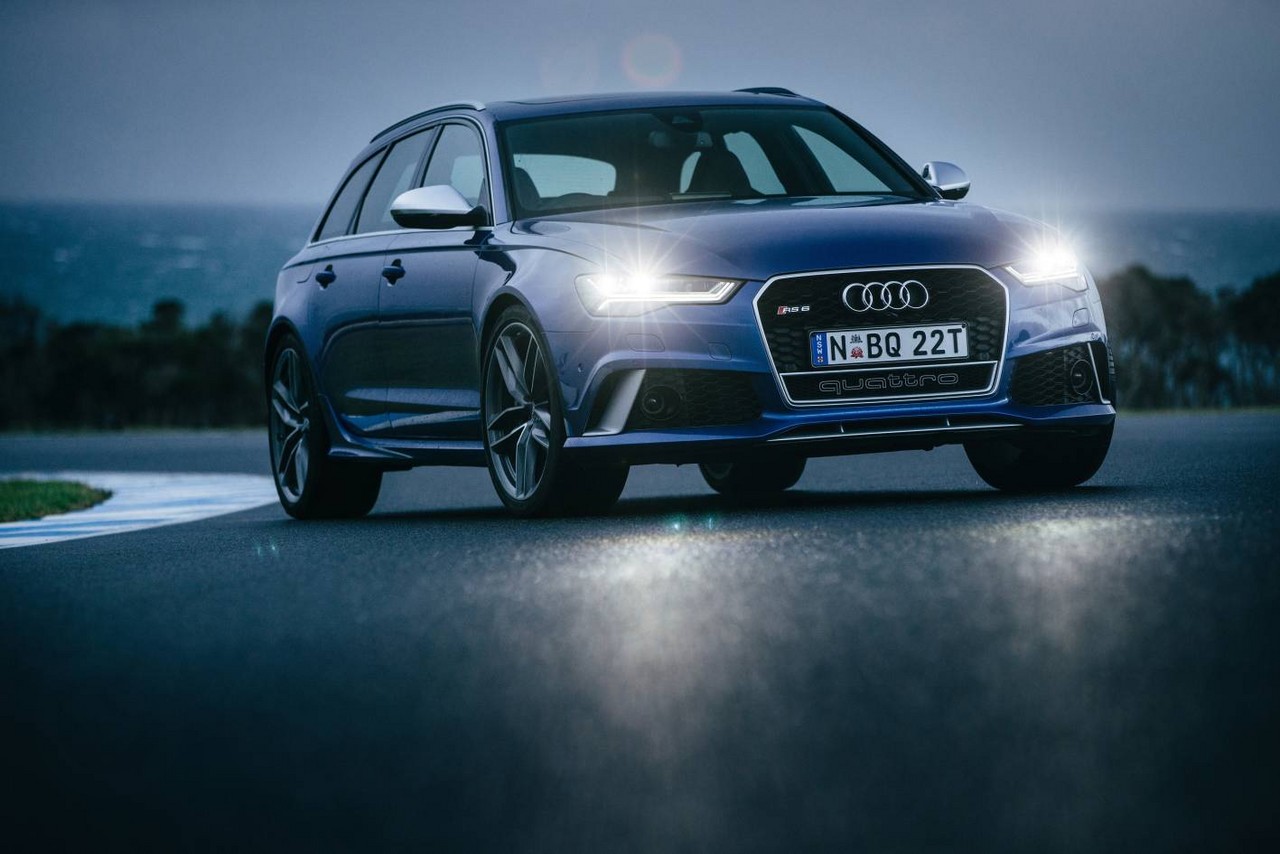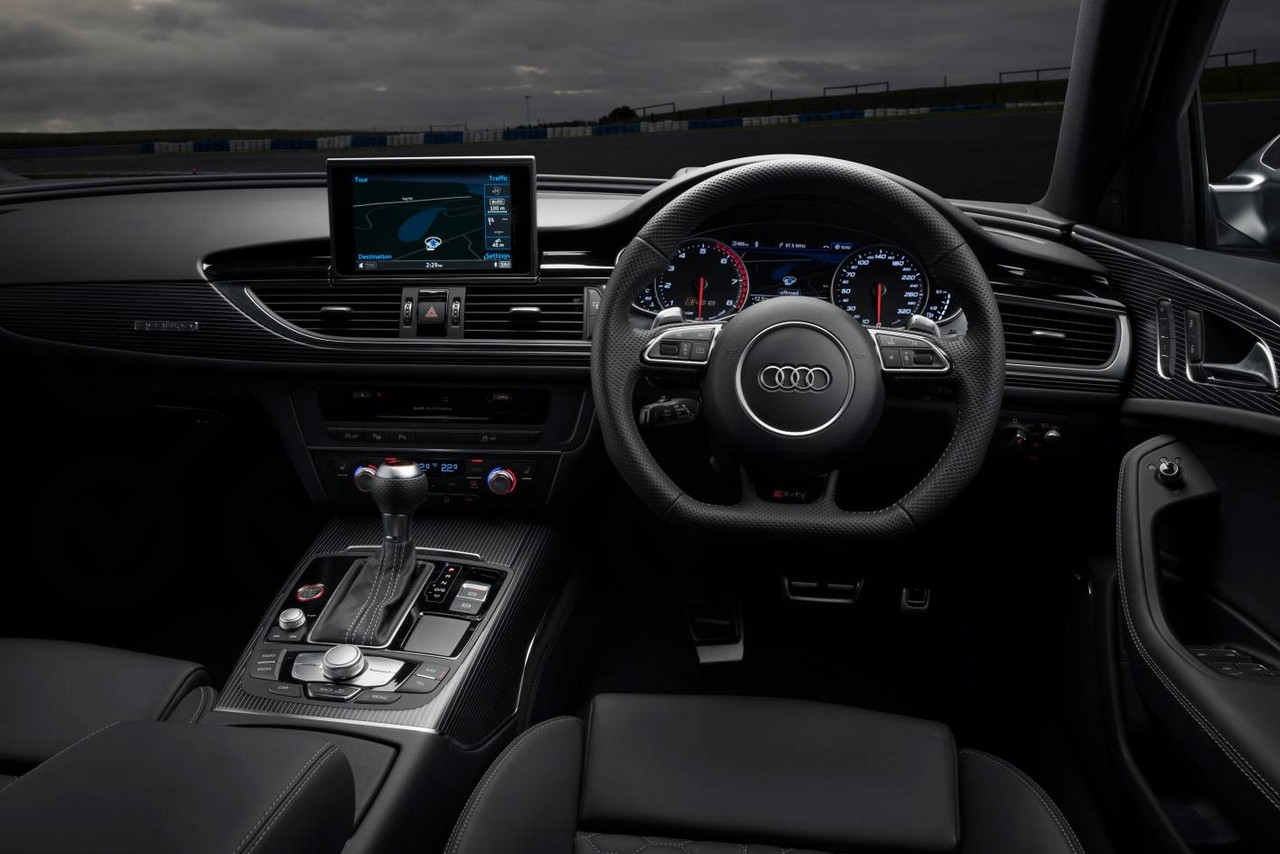
- Twin-turbo V8 engine has power and character
- Excellent ride/handling balance for air suspension
- Quattro system provides immense traction
- High standard of interior fit and finish
- Steering lacks feel and feedback
- Steel spring suspension lacks compliance
- Weight blunts agility
- High maintenance costs
Review: Audi C7.I RS6 Avant (2013-14)
Overview
Released in Australia in October 2013, the Audi C7 Series I (C7.I) RS6 Avant was a high-performance wagon. Manufactured in Neckarsulm, Germany, the four-wheel drive Audi C7 RS6 Avant was powered by a 4.0 twin turbo V8 petrol engine that was mated to an eight-speed ‘Tiptronic’ automatic transmission.
4.0 TFSI V8: CRDB engine
The C7 RS6 was powered by Audi’s CRDB engine which had a hypereutectic aluminium-silicon alloy block, forged steel crankshaft, aluminium alloy cylinder head with ‘hot side in’ design, double overhead camshafts with rear chain drives, variable intake and exhaust camshaft timing, direct fuel injection (Audi’s ‘Fuel Stratified Injection’ or FSI) and a compression ratio of 10.1:1. Significantly, the CRDB engine had two twin-scroll turbochargers mounted in the engine’s inner ‘V’ which provided relative boost pressure of up to 1.2 bar and water-cooled intercoolers to condense the intake air.
The CRDB engine also featured:
- A ‘cylinder on demand’ management system which could shut down the intake and exhaust valves of cylinders 2, 3, 5 and 8 at low to intermediate engine speeds. Furthermore, active engine bearings used out-of-phase counter-oscillations to compensate for the vibrations that occurred during four-cylinder operation; and,
- A start-stop function which enabled the engine to shut down when the vehicle was stationary to reduce fuel consumption.
The C7 RS6 Avant could accelerate from rest to 100 km/h in 3.9 seconds and, in standard configuration, had an electronically-limited top speed of 250 km/h. This top speed, however, could be increased to 280 km/h with an optional ‘Dynamic’ package and to 305 km/h with the ‘Dynamic plus’ package.
| Engine | Trans. | Peak power | Peak torque | |
|---|---|---|---|---|
| C7 RS6 Avant | 4.0-litre CRDB twin-turbo petrol V8 | 8sp auto | 412 kW at 5700-6700 rpm | 700 Nm at 1750-5500 rpm |
Dimensions and body
Compared to the Audi C6 RS6 , the C7 RS6 Avant was 51 mm longer (at 4979 mm), 47 mm wider (1936 mm), 1 mm taller (1461 mm) and had a 69 mm longer wheelbase (2915 mm). Furthermore, the increased use of aluminium for its body (approximately 20 per cent) and high-strength steel contributed to an approximate 100 kg reduction in kerb mass.
Suspension and steering
Like the related Audi C7 A6 and Audi C7 S6 , the RS6 Avant had five-link front suspension and self-tracking trapezoidal link rear suspension. The C7 RS6 Avant, however, also had an air suspension system which varied damping forces according to road conditions, driving style and the drive mode selected from the ‘Audi drive select’ menu. As an alternative to the adaptive air suspension system, the RS6 Avant was also offered with a firmer ‘sport suspension plus’ configuration which consisted of conventional steel springs and three-way adjustable shock absorbers which were interconnected diagonally by means of oil lines and a central valve (for improved body roll stability).
The Audi C7 RS6 Avant had electromechanical power steering with an optional ‘dynamic steering’ function for variable steering assistance and ratios.
quattro system
The Audi RS6’s quattro four-wheel drive system utilised a self-locking ‘Crown Gear’ centre differential which, in normal conditions, provided a 40:60 front:rear torque split. If traction was lost, however, up to 85 per cent of the engine’s torque could be directed to the rear axle, or up to 70 per cent to the front axle. The system also included open front and rear differentials with electronic differential locks which could brake spinning wheels to enable cross-axle torque transfers.
The RS6 also had a rear-wheel ‘torque vectoring’ function which could selectively distribute torque to the rear wheels to generate yaw and thereby correct over- or under-steer.
Safety equipment
Standard safety equipment for the Audi RS6 Avant included dual front airbags, front and rear side airbags, full-length curtain airbags (i.e. for front and rear occupants), ABS, electronic brake force distribution, brake assist, electronic stability control, traction control and front seatbelts with pretensioners and load limiters.
Euro NCAP testing
In Euro NCAP testing , the related Audi C7 A6 2.0 TDI received a five star safety rating with a 91 per cent adult occupant protection rating and an 83 per cent child occupant protection rating. In the offset crash test, there was a slight risk of serious chest and leg injury for the driver. In the side impact test, one point was deducted because the driver door unlatched. Under ANCAP’s methodology , this testing resulted in an adult occupant protection rating of 34.91 out of 37.
Features: Audi C7 RS6 Avant
Standard features for the Audi RS6 Avant included 21-inch cast aluminium alloy wheels, a 600 watt Bose surround sound system with 14 speakers and a twelve-channel digital sound processing amplifier, a CD/DVD player, digital TV and radio (DAB plus) reception, Bluetooth interface with audio streaming, Audi’s Multi Media Interface (MMI) with HDD navigation and eight-inch monitor and touch pad, head-up display, four-zone climate control air conditioning, Valcona leather upholstery, power adjustable and heated front sports seats, cruise control, LED headlights, front and rear parking sensors, a ‘360 degree’ camera, a leather-wrapped steering wheel with gearshift paddles, remote central locking, power windows, power adjustable mirrors with folding function, a power adjustable steering column (height and reach), driver memory settings (for seat, mirrors and steering column), a panoramic glass sunroof, power-operated tailgate with ‘gesture control’, tyre pressure monitoring, ambient lighting, a trip computer and an immobiliser.
Related links
- Press Kit: Audi C7 RS6 (July 2013)
- Specifications: Audi C7 RS6 (July 2013)
- Technical data: Audi C7 RS6 (July 2013)
Review: Audi C7.II RS6 (2015-18)
Overview
Officially released in Australia in May 2015, the C7 Series II (C7.II) RS6 could be identified by its revised headlights, single frame grille, air inlets, bumpers, side sills, rear lights and tailpipes. Within the instrument cluster, there was a new high-resolution ‘Driver Information System’ (DIS) – positioned between the speedometer and tachometer – which could provide map-based navigation. The DIS was powered by the MIB2 infotainment system which used an NVIDIA Tegra 30 quad-core processor.
Although power and torque outputs were unchanged, the C7.II RS6 engine was revised for Euro VI emissions compliance; fuel consumption was also reduced to 9.6 litres per 100 km for the ADR 81/02 test cycle.
Audi RS6 Avant performance
Production of the Audi RS6 Avant performance commenced in late 2015 with deliveries expected in early 2016. Compared to the standard 4.0 TFSI engine, the engine for RS6 Avant performance has:
- Modified exhaust valves;
- A 200 rpm increase in maximum engine speed;
- ‘Optimised inner geometry’ for the turbochargers;
- An overboost function which increased on-demand torque from 700 Nm to 750 Nm. If the engine/transmission setting is in ‘dynamic’ mode, the overboost function is activated automatically under full load; and,
- Unique engine management system.
The RS6 Avant performance could accelerate from rest to 100 km/h in 3.7 seconds (compared to 3.9 seconds for the standard C7 RS6 Avant), though fuel consumption was unchanged.
| Engine | Trans. | Peak power | Peak torque | |
|---|---|---|---|---|
| C7 RS6 Avant | 4.0-litre CRDB twin-turbo petrol V8 | 8sp auto | 412 kW at 5700-6700 rpm | 700 Nm at 1750-5500 rpm |
| C7 RS6 Avant performance | 4.0-litre twin-turbo petrol V8 | 8sp auto | 445 kW at 6100-6800 rpm | 750 Nm at 1750-6000 rpm (overboost) |
Safety equipment
For the Audi C7.II RS6, standard safety equipment was extended to include:
- Audi’s ‘pre sense plus’ system: the pre sense plus system used two long range radars and a windscreen-mounted to camera to detect obstacles ahead. If the onboard computer determined that a collision was likely, visual and acoustic warnings would be given and the brake system would be pre-filled. If the driver failed to react, a braking jolt would occur as a ‘haptic’ warning, the braking system prepared so that if the driver did apply the brakes, then the appropriate braking force would be applied. If there was still no reaction from the driver, the system would apply partial braking to mitigate the collision and, if a collision could not be avoided, maximum braking force would be autonomously applied to reduce the severity of the collision;
- Adaptive cruise control (ACC): radar-based cruise control which maintained a pre-set distance from the car ahead. For the RS6, ACC included a ‘stop & go’ function for low speeds which could bring the vehicle to a stop and accelerate from rest;
- Audi active lane assist: operating at speeds in excess of 65 km/h, a video camera could detect lane markings. If the vehicle approached a lane marking without indicating, the steering system would make automatic adjustments to keep the vehicle in its lane. The steering wheel could also be set to vibrate to warn the driver;
- Audi side assist: used two radar sensors to monitor the area 70 metres behind the vehicle during lane change manoeuvres at speeds over 30 km/h. If there was a vehicle in the driver’s blind spot or an approaching vehicle was detected, the driver would be alerted by a warning LED in the respective door mirror. If the driver activated the turn signal, the LED would flash several times at high frequency; and,
- Audi pre sense rear: if a rear-end collision was anticipated, the seats would be moved into the safest position for a collision.
Features: Audi C7.II RS6 Avant
Standard features for the Audi C7.II RS6 Avant were extended to include Matrix beam LED headlights which could dim specific diodes to divert their pool of light around oncoming and following traffic without reducing their intensity in other areas; dynamic indicators were also fitted as standard.
Features: Audi RS6 Avant performance
The Audi RS6 Avant performance was fitted with 21-inch cast aluminium wheels with an exclusive 5-V-spoke star design in matt titanium look with a gloss turned finished. Visually, the RS6 Avant performance could be identified by the ‘quattro’ logo on the air inlet duct and add-18 parts in matt titanium look including the frame of the Singleframe grille, the front spoiler and the lateral flaps in the air inlets, the trim strips at the side windows, the exterior mirror housings and the top edge of the diffuser insert at the rear of the vehicle. Furthermore, the roof rails for the RS6 Avant performance were finished in matt titanium look.
Inside, the RS6 Avant performance featured combination Alcantara and Valcona upholstery, contrasting blue honeycomb stitching and a carbon-fibre ‘blue twill’ inlay.
Related links
- Audi Australia: Audi RS6
- Specifications: Audi C7.II RS6 Avant (May 2015)
- Technical Data: Audi C7.II RS6 Avant (May 2015)
- Wikipedia.org: Audi C7 RS6
